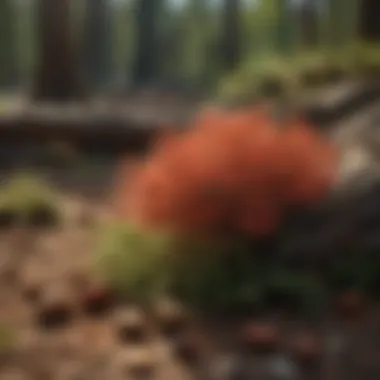Mastering Tree Seed Identification Techniques


Intro
Tree seeds serve as a gateway to understanding the intricate world of forestry and woodland management. Identifying these seeds is not merely a skill; it is an essential practice that fosters better management and conservation of forest ecosystems. A deeper insight into seed characteristics allows forestry professionals and environmental enthusiasts to appreciate the diversity and complexity of tree species.
As we engage in this exploration, we will focus on various aspects of identifying tree seeds. Understanding the biological factors that help distinguish one seed from another is crucial. Factors such as size, shape, color, and texture are often the first indicators. Moreover, the environment in which a tree grows adds layers of complexity to identification. This guide will emphasize techniques and methodologies that can be applied in practical scenarios, benefiting both seasoned professionals and those new to forestry.
The significance of this knowledge extends beyond identification. It is intertwined with sustainable forestry practices, highlighting the essential role of trees in global ecosystems. Trees contribute to carbon sequestration, biodiversity, and soil health.
Through this article, we aim to provide valuable insights that will enhance understanding and appreciation for tree seeds, ultimately contributing to better forestry management and conservation efforts.
Preamble to Tree Seeds
Understanding tree seeds is a critical component in the fields of forestry and ecology. They serve not only as the means of reproduction for trees but also play a pivotal role in the health of forest ecosystems. Identifying tree seeds enables professionals and enthusiasts to appreciate biodiversity, monitor ecosystems, and implement effective conservation strategies. The ability to accurately recognize different tree seeds is beneficial, particularly in the context of climate change and habitat preservation. Knowledge about seed identification aids in selecting appropriate species for reforestation and afforestation efforts. As various factors like soil types, climates, and biomes influence tree growth, recognizing these seeds helps in making informed decisions.
Importance of Seed Identification
Seed identification is vital for several reasons. First, an accurate identification can assist in the conservation of rare and endangered tree species. For instance, foresters can ensure that specific seeds are planted in suitable habitats, improving the survival rates of these trees. Additionally, understanding the origin and characteristics of seeds can support restoration ecologists in reviving disturbed areas by choosing the right species to cultivate. Furthermore, seed identification allows researchers and woodland managers to track tree population changes and their responses to ecological shifts. This is crucial for sustainable management practices that aim to maintain forest health and biodiversity.
Overview of Seed Characteristics
To effectively identify tree seeds, one must consider several characteristics that distinguish them from one another. These characteristics include size, shape, surface texture, and color. Seed size can vary significantly across species; some tree seeds, like those from the giant redwood, can be quite large, while others, like the silver birch, are much smaller.
The shape of the seeds can range from elongated to rounded or even uniquely structured. Surface texture is another differentiating feature; for example, some seeds have smooth coats, while others might display rough textures or patterns of ridges and furrows. Color also plays a role, as seeds may present in shades of brown, black, or even bright colors depending on the species.
Key characteristics include:
- Size: Varies greatly between species
- Shape: Can be elongated, rounded, or irregular
- Texture: Ranges from smooth to rough
- Color: Includes various shades, aiding in identification
Understanding these key characteristics is essential as they provide the foundation for distinguishing between tree species, thereby enhancing one's ability to navigate complex woodland environments.
Biological Foundations of Seed Identification
Understanding the biological foundations of seed identification is crucial for anyone involved in forestry and ecological management. This knowledge allows practitioners to recognize various seed types, which directly influences successful reforestation efforts, conservation practices, and the management of biodiversity. A deeper comprehension of how seeds develop and their anatomical structures enriches the ability to correctly identify seeds, therefore leading to better forest management outcomes.
Anatomy of Tree Seeds
The anatomy of tree seeds is fundamental for identification. By examining the essential parts of a seed, one can differentiate between species and better understand their growth habits and requirements. The main components of tree seeds include the seed coat, cotyledons, and embryo. Each of these structures plays a distinct role in seed survival and germination.
Seed Coat
The seed coat serves as the protective barrier of the seed, shielding the inner components from physical damage and environmental stress. This outer layer can vary widely in texture, thickness, and color across different species. One key characteristic of seed coats is their role in preventing desiccation. Many seeds have hard coats that limit water loss.
This quality makes seed coats a beneficial aspect of identification since the distinctiveness in texture can indicate specific tree types. For instance, the thick, woody coat of a total leaf tree contrasts sharply with the delicate seed coats found in many kinds of pines. However, it is important to note that while a hard seed coat can protect the seed, it may also impede water absorption, potentially delaying germination.
Cotyledons
Next, the cotyledons are critical for providing energy to the developing seedling. These structures are the first leaves that emerge during germination and are essential for photosynthesis in the seedling's early life. Their shape, number, and arrangement offer insights into the tree species.
Cotyledons can come in various forms. For example, many broadleaf species possess two cotyledons, unlike conifers that usually have one. The presence and morphology of cotyledons make them a good choice for identification, as they can help distinguish species. However, a disadvantage is that cotyledons can sometimes look similar in certain species, which may lead to confusion among novices.
Embryo
The embryo is, without doubt, the most vital part of the seed. It is the young plant itself, containing the initial structures that develop into the root and shoot system. The embryo's size, shape, and development status can reveal important information about the seed's viability and potential for growth.


A significant characteristic of the embryo is its correlation with the seed's germination requirements. For example, certain species have embryos that require specific environmental cues for successful germination. This means understanding embryos is essential for predicting how seeds will behave under different conditions. Nevertheless, embryos may be challenging to observe without appropriate dissection methods, limiting their accessibility for some identification practices.
Seed Development and Maturation
Seed development and maturation encompass the processes by which the embryo and surrounding tissues mature from fertilization to a viable seed. This phase is critical as it influences the seed's ability to germinate effectively later on. Environmental factors such as light, temperature, and moisture during this period can significantly affect the quality of the seed produced.
Knowing how seeds develop enables keen identification skills. Seeds that develop in specific conditions may exhibit unique variations in their structure and functionality, aiding in the differentiation between species. The understanding of seed maturation also assists in determining the optimal time for harvesting seeds and preparing for their use in reforestation efforts.
In summary, familiarizing oneself with the biological foundations of seed identification through the study of seed anatomy and development can enhance the accuracy of identifying tree seeds. This knowledge supports better insights into forestry practices and biodiversity conservation.
Morphological Characteristics of Tree Seeds
Understanding the morphological characteristics of tree seeds is vital for accurate identification and knowledge of seed diversity. These characteristics include shape, size, color, and specialized structures. Each aspect plays a crucial role in aiding forestry professionals, researchers, and enthusiasts alike in distinguishing one species from another. This understanding not only supports ecological studies but also informs effective forest management practices.
Shape and Size Variations
The shape and size of tree seeds can vary widely across species, and these variations are often critical for identification. Seeds can be round, oval, flat, or elongated. For example, the seeds of the maple tree are typically winged and have a characteristic samara shape, while the acorn of an oak tree has a more rounded form.
Size also plays a significant role; some seeds, like those of the cotton tree, are very large, while others, such as those from grasses, can be minuscule. Making observations about shape and size can greatly assist in recognizing species, as certain shapes may be unique to specific tree varieties.
Color and Texture
Color and texture are additional key morphological traits that provide useful hints in seed identification. Seeds can be dull or shiny, and their colors may range from beige to black, or even vibrant hues in some species. For instance, the seeds of the redbud tree have a smooth texture and are often dark purple.
These visual traits can be consciously observed during the identification process. Additionally, the texture of the seed coat can reveal a lot about its dispersal mechanisms and environmental adaptations. Seeds with rough surfaces may adhere better to animal fur or skin, thus aiding in animal-facilitated dispersal.
Specialized Structures
Specialized structures, such as wings, hooks, and spines, offer essential information about seed capabilities and adaptations. They often contribute to the seed's dispersal strategies or protection.
Wings
Wings on seeds serve a distinct purpose in enhancing dispersal by wind. Seeds such as those from the Ash tree have developed these wing-like structures. The presence of wings allows seeds to be carried over long distances, increasing the potential for germination in suitable locations.
This adaptation is especially important in open habitats where opportunities for seedling establishment can be widely distributed. However, when conditions are unfavorable, wings may also increase the risk of being lost to unsuitable areas, showcasing a balance between advantages and drawbacks.
Hooks
Hooks play a similar role, primarily concerning animal dispersal. Seeds with hooks, like those of the Burdock plant, can attach themselves to animal fur or clothing. This method not only facilitates transportation but also tends to ensure that seeds are delivered to new environments away from the parent plant. While this is beneficial for spreading species, reliance on animals for dispersal can pose risks if fewer dispersers are present.
Spines
Spines can act as a defensive mechanism for seeds, protecting them from predation. For instance, seeds of the Devil's Club have spiny structures that deter many herbivores. While this attribute helps protect seeds, it can also hinder potential symbiotic relationships with species that might assist in germination or dispersion, bringing certain challenges to their ecological strategy.
In summary, studying morphological characteristics such as shape, size, color, texture, and specialized structures is essential in the context of tree seed identification. It deepens our understanding and appreciation of the intricate details that facilitate forest ecosystems' functioning.
Ecological and Environmental Factors
Understanding ecological and environmental factors is crucial in the context of tree seed identification. These factors significantly influence tree species distribution, reproductive success, and the survival rates of seeds in various environments. By studying the interplay between these factors and seed behavior, professionals in forestry and ecologists can gain deeper insights into forest dynamics, vital for conservation and sustainable management practices.
Seed Dispersal Mechanisms
Seed dispersal is an ecological process that helps in the distribution of tree species. It plays a vital role in genetic diversity, species coexistence, and ecosystem health. Two common mechanisms are wind dispersal and animal-facilitated dispersal. Each has its unique characteristics and implications for seed identification.


Wind Dispersal
Wind dispersal is a method used by many tree species to spread their seeds over wide areas. This mechanism involves the release of seeds that are designed to be carried by the wind. A key characteristic of wind-dispersed seeds is their lightweight, which often includes structures like wings or tufts of hair that enhance aerial travel.
This method is beneficial because it allows seeds to colonize new areas quickly. Seeds like those from the maple or dandelion are excellent examples of wind dispersal. The unique feature of wind dispersal is the reliance on atmospheric conditions. This can be advantageous during favorable weather but may also lead to disadvantageous outcomes, such as seeds landing in unsuitable habitats, which impacts germination rates.
Animal-Facilitated Dispersal
Animal-facilitated dispersal refers to the process by which animals transport seeds from one location to another. This mechanism relies on animals either consuming seeds or carrying them in their fur or feathers. A notable characteristic of this method is its ability to ensure that seeds are deposited in nutrient-rich waste, enhancing seedling survival.
In this case, seeds from plants like berry-producing shrubs are often effectively dispersed by birds. This dispersal method is popular in the article due to its dual advantage: it not only spreads seeds but also aids in seed germination through interactions with animal metabolism. However, reliance on animals does have its downsides, such as the unpredictability of animal behavior and the potential for overconsumption of seeds.
Adaptations to Environmental Conditions
Tree seeds exhibit various adaptations to cope with their environmental conditions. These adaptations may include changes in dormancy, timing of germination, and physical traits for protection against herbivory or harsh climate. For instance, seeds from the pine tree often have a hard outer shell, allowing them to withstand extreme temperatures and remain viable for extended periods.
Techniques for Identifying Tree Seeds
Identifying tree seeds is crucial for anyone involved in forestry and woodland management. The ability to effectively categorize seeds aids in conservation efforts, promotes biodiversity, and enhances sustainable practices. Techniques for identifying tree seeds encompass both practical methods and advanced scientific approaches. Each method contributes significantly to achieving accurate identification, which is essential for maintaining healthy ecosystems.
Field Identification Methods
Visual Observation
Visual observation refers to the straightforward method of identifying tree seeds through direct examination. This technique relies heavily on the keen observation skills of an individual. A key characteristic of visual observation is its immediacy. It allows for quick assessments in natural environments. The benefits of this method include accessibility and time efficiency. Fieldworkers and enthusiasts can often identify tree seeds based merely on their size, shape, and sometimes color.
However, the unique feature that visual observation offers could also become its limitation. Some seeds may resemble each other closely, leading to potential misidentification. Therefore, while visual observation is popular, it should be supported by further methods for confirmation.
Use of Field Guides
The use of field guides involves referencing published manuals specifically designed for tree seed identification. These guides provide descriptions and images of various seeds, which facilitate accurate identification. A primary advantage of field guides is their comprehensive nature. They integrate visual and textual information that helps users to compare features effectively.
Many forestry professionals favor field guides for their portable convenience and the vast range of species covered. However, the unique feature of field guides is their reliance on the user's ability to interpret the information accurately. Misinterpretation of descriptions can lead to confusion, indicating that while field guides are beneficial, they require careful consultation.
Laboratory Techniques
Microscopic Analysis
Microscopic analysis employs advanced tools to study tree seeds in detail. This technique allows researchers to observe structures not visible to the naked eye, such as cellular patterns on seed coats. A key benefit of microscopic analysis is precision. This method can distinguish between seeds that appear similar at first glance.
The unique feature of microscopic analysis is its ability to reveal intricate details that contribute to accurate identification. However, it requires specialized equipment and training, which may not be accessible to all practitioners. Thus, while it is effective, it is not practical for everyday fieldwork.
Genetic Profiling
Genetic profiling involves analyzing the DNA of tree seeds to establish their identity. This is an especially useful technique when dealing with hybrid or closely related species. A noteworthy aspect of genetic profiling is its accuracy. It eliminates ambiguity that may arise from morphological similarities.
The unique feature of genetic profiling is its foundation in molecular biology, offering profound insights into genetic relationships among species. However, it is a costly and time-consuming method. While it provides invaluable information, the constraints of resources limit its use in routine identification practices.
Understanding these techniques enhances the effectiveness of identifying tree seeds, supporting the overall goals of forestry and conservation.
Challenges in Seed Identification
Identifying tree seeds is a nuanced endeavor, beset with a variety of challenges. The field of plant identification is complex, and those who engage in it must navigate numerous pitfalls. Misleading characteristics and environmental factors often obscure the true identity of a seed. Thus, understanding these challenges is crucial for accuracy in forestry and research.


The ability to correctly identify seeds not only supports biodiversity but also enhances conservation efforts.
Common Misidentifications
Common misidentifications stem from several sources. One primary source is the morphological similarity among different species. For instance, tree seeds such as those from the maple and ash may appear quite alike to the untrained eye. This visual similarity can lead to errors in categorization, ultimately impacting ecological studies and management practices.
Furthermore, the use of poorly maintained or inaccurate field guides can amplify these issues. If guides do not reflect current taxonomies or variations in local populations, the likelihood of misidentification increases significantly. Misidentification not only affects scientific research but can also have cascading effects on forest management decisions, impacting species conservation and resource allocation.
Impact of Hybridization
Hybridization is another notable challenge in seed identification. As species cross-pollinate, they may produce hybrid seeds that possess characteristics of both parent species. This genetic blending complicates identification efforts, especially in regions where hybridization is common. For example, trees such as oaks may show hybrid traits that diverge from their typical seed morphologies. The presence of hybrids can obscure the seed profile and confuse those attempting to classify them.
Moreover, hybrids may display unique adaptations or ecological behaviors that differ from pure species. Understanding these differences is vital for effective ecological research and forest management strategies. Therefore, acknowledging hybridization's role in seed identification challenges underscores the importance of adapting methodologies to accurately reflect the complexities of biodiversity.
Resources for Further Research
In the realm of tree seed identification, the availability of diverse resources is crucial. These tools not only facilitate accurate identification but also enrich the understanding of forest ecosystems. Proper research equips forestry professionals and academics with the ability to make informed decisions, which can ultimately influence conservation and management strategies.
Identification Guides and Manuals
Identification guides and manuals serve as foundational resources for anyone engaged in tree seed identification. They often provide extensive information about species characteristics, geographical distribution, and specific identification techniques.
A few notable aspects of these guides include:
- Visual Diagrams: Clear images can help in distinguishing similar species.
- Key Identification Features: Guides emphasize colors, shapes, and textures which are essential for field identification.
- Seasonal Variations: Some manuals include seasonal changes in seed appearance which is important for accurate identification.
Moreover, these guides can be physical books or accessed digitally. Professional editions like "Tree Seed Biology" may offer comprehensive data. Local extension services or university forestry programs often have tailored manuals that focus on regional flora. Such specificity aids in better understanding the local biodiversity.
Online Databases and Communities
Online databases and communities have emerged as vital platforms for modern researchers and enthusiasts. They provide updated information about various tree seed types and allow for interaction among experts and novices.
The advantages of utilizing these resources include:
- Current Research Access: Online databases frequently update their datasets, reflecting the latest in taxonomic revisions or seed characteristics.
- Global Networking: Communities like Reddit can connect tree seed enthusiasts from different backgrounds, fostering a platform for sharing insights and experiences.
- Interactive Identification Tools: Many databases offer sorting tools where users can input characteristics to narrow down possible species. This interactive approach aids in learning and knowledge retention.
For instance, the website en.wikipedia.org provides a plethora of information on tree species and their seeds, while britannica.com houses articles that delve into the environmental impacts on tree species. Engaging with platforms like reddit.com can lead to discussions that expand understanding and enhance identification skills.
Engaging with both guides and online communities allows for a comprehensive learning approach, echoing the dynamic nature of forestry and environmental science.
Having access to a variety of resources allows both professionals and hobbyists to remain at the forefront of knowledge in tree seed identification. By continuously updating their understanding through these tools, individuals can contribute positively to sustainable forestry practices.
Closure
In this article, we explored the crucial elements of identifying tree seeds. The process of seed identification is not merely an academic exercise; it plays a significant role in managing and conserving forest ecosystems. Understanding the nuances of tree seed identification aids not just in recognizing species but also in appreciating the biodiversity within forested environments. This knowledge contributes to sustainable forestry practices, ensuring the health and viability of tree populations.
The Significance of Identifying Tree Seeds
Identifying tree seeds is essential for a number of reasons. First, it informs reforestation efforts. When planting new trees, knowing the correct species to introduce can help maintain ecological balance. Each species has specific growth requirements and interactions within its ecosystem. Furthermore, seed identification helps in the conservation of rare and endangered species. Recognizing seeds from these trees can facilitate targeted conservation strategies and preservation efforts.
Secondly, tree seeds provide insights into environmental health. Changes in seed dispersal and germination patterns can indicate shifts in climate or habitat conditions. By monitoring these patterns, forestry professionals can make informed decisions to mitigate negative impacts on forest ecosystems.
Lastly, identification of tree seeds enriches scientific research. It lays foundational knowledge needed for various studies, from genetics to ecological interactions. Scientists can explore how tree species adapt over time and respond to environmental pressures. This research is vital in today’s world, where forests face numerous challenges from climate change and human activity.
Call to Action for Woodland Stewardship
The responsibility for maintaining healthy forests falls on both professionals and the public. To ensure sustainable woodland stewardship, we must advocate for continued education and awareness regarding tree seed identification. By sharing knowledge, resources, and tools, we can empower communities to engage in local conservation efforts. This can involve workshops, educational programs, and the utilization of online resources like Wikipedia, Britannica for deeper insights.
Moreover, engaging with platforms such as Reddit or Facebook can create networks for sharing experiences, tips, and discoveries related to seed identification. Encouraging amateur enthusiasts to contribute to certifying tree seeds can expand the resource pool, benefiting both local ecosystems and broader conservation initiatives.
Ultimately, your involvement matters. Through informed practices and community outreach, we can enhance our collective understanding of tree seeds and their crucial role in the environmental framework. Every action counts in preserving our natural heritage and ensuring the future resilience of our forests.







